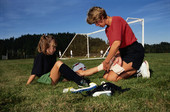
TUESDAY, March 19 (HealthDay News) — Football has been blamed for a growing number of injuries among young players in the past decade, but a new study finds that football is an exception, and injuries from most other popular sports have dropped in children.
The study compared the number of injuries in children aged between 5 and 14 that occurred in 2000, 2005 and 2010 based on a national survey of the emergency rooms of about 100 hospitals.
It focused on eight popular activities: football, basketball, baseball/softball, soccer, bicycling, roller sports such as skating, playground use and trampoline use.
The study is scheduled for presentation Tuesday at the annual meeting of the American Academy of Orthopaedic Surgeons, in Chicago.
“Physicians and children’s hospitals have reported an increase in injuries from pediatric sports and the number of surgeries on kids [but] there was no population-based study to see if there is a real increase,” said study author Dr. Shital Parikh, an associate professor of pediatric surgery at Cincinnati Children’s Hospital.
Parikh’s analysis suggests that the number of acute injuries, in particular sprains and fractures, has declined over the past decade. The study does not, however, address trends in chronic wear-and-tear damage and injuries that require surgery, such as a torn ligament, and these types of injuries have probably increased, he said.
The study found a more than 13 percent decrease in the rate of injuries seen in emergency rooms between 2000 and 2005 but only a roughly 1 percent decrease between 2000 and 2010.
The rebound in the number of injuries in 2010 appears to be due largely to an increase in the injuries related to football, baseball/softball and soccer between 2005 and 2010.
Looking at the population using U.S. Census Bureau data, Parikh found that for every 1,000 children, 31.9 sustained an injury in 2000 whereas 27.6 and 31.6 did so in 2005 and 2010, respectively.
The biggest drop in injury rate was for bicycling, which saw a more than 29 percent decrease between 2000 and 2005 and a 38 percent decrease overall. During this decade, the sport went from the most dangerous to the second most dangerous.
There were also drops in roller-sport and trampoline injuries of nearly 21 percent and 17.5 percent, respectively, between 2000 and 2010, and to a lesser extent, fewer injuries related to basketball.
Football injury rates, however, shot up by nearly 23 percent between 2000 and 2010, and soccer injuries rose by almost 11 percent.
Muscle and skeletal injuries, such as fractures, sprains and bruises from football and soccer rose by about 24 percent and 9 percent, respectively. Rates of these injuries declined for the other sports, except for baseball and softball, which saw a 2.5 percent increase.
Football and soccer injuries also increased to a larger extent for children between 10 and 14 years old compared to children between 5 and 9 years old.
These trends “may reflect the changing pattern of exposure in kids,” Parikh said. “There may be a decrease in bicycling and an increase in football [injuries] as kids are doing more organized sports than free play.”
The push could be coming from parents, coaches and schools alike, Parikh said. He added, however, that “free play is equally important and we should not be pushing them into organized sports because they can be more competitive.”
Dr. Corinna Franklin, a pediatric orthopedic surgeon at Shriner’s Hospital for Children in Boston, agreed.
“Overuse and overtraining are also major concerns,” Franklin said. “As children become good at competitive sports, there is sometimes an impulse to keep them in the same sport year round, which may not be the healthiest thing for a young athlete.”
Parikh added that kids also aren’t stretching, warming up or cooling down properly, although the protective equipment in most sports seems to be adequate.
On the bright side, injuries related to bicycling and trampoline use have probably decreased because of better safety, and not just because kids are doing less of it, Parikh said.
A big reason for the decrease in total injuries related to bicycling is probably because of fewer head injuries, Parikh said. “More kids may be using helmets and there is more adult supervision and protective gear,” he added.
Parikh attributed improved safety partly to policy statements from the American Academy of Pediatrics and other organizations, which could have increased efforts among physicians to make parents and coaches more aware of how to prevent injuries.
Franklin said she is hopeful that the STOP Sports Injuries campaign and website from the American Orthopaedic Society for Sports Medicine for parents, coaches and doctors will help as well.
Data and conclusions from studies presented at medical meetings are considered preliminary until published in a peer-reviewed medical journal.
More information
To learn more about sports injuries in kids, visit the STOP Sports Injuries website.

